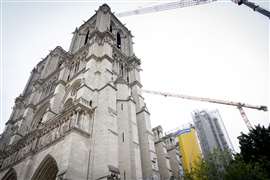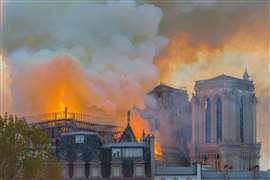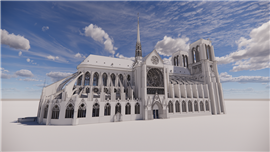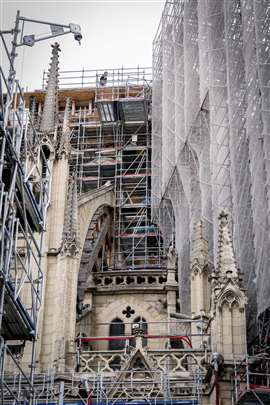How Notre-Dame reconstruction is on track 5 years on from fire
03 April 2024
 Image: Laurent Blevennec/Présidence de la République France
Image: Laurent Blevennec/Présidence de la République France
It’s nearly five years since a major structural fire caused devastating damage to the 860-year-old Notre-Dame cathedral in Paris.
The fire, possibly linked to renovation work that was going on at the time, destroyed the cathedral’s ancient timber roof structure and caused its spire, rebuilt in 1859, to collapse.
While the vaulted ceiling of the vast stone building beneath it largely contained the collapse of the roof – a testament to the medieval builders who constructed it – it gouged a large hole in the roof at the transept crossing (where the nave of the church and the transept intersect), as well as piercing the vaulted ceiling in some central parts of the nave and in the northern arm of the transept. The transept’s north and south gables and the nave’s west gable were also badly damaged.
 Notre-Dame on fire (Image: David Henry via AdobeStock - stock.adobe.com)
Notre-Dame on fire (Image: David Henry via AdobeStock - stock.adobe.com)
In the aftermath, French President Emmanuel Macron vowed to rebuild the cathedral in just five years. Setting such an ambitious time limit on the complex reconstruction of one of France’s greatest national monuments looked risky.
But the Cathedral is set to re-open in December this year, and renovation work is said to be 90% complete, even if it will continue after that date and into 2028. Macron has already invited the Pope to attend.
Such has been the progress, in fact, that scaffolding for the first two bays of the nave and the aisles was already taken down in early spring last year, with scaffolding around the nave chapels following in the summer. Last month (February), saw the scaffolding removed around the newly reconstructed, 96m-tall spire, which is a faithful reconstruction of the 1859 version designed by architect Eugène Viollet-le-Duc.
By the time the Paris Olympics roll around this summer, some scaffolding will remain but the progress on the cathedral’s construction five years on will be clear to see.
Funding, faithful approach, and digital design
All of this work has been at minimal cost to the French public purse.
The final cost of the reconstruction isn’t completely set yet but is expected to be around €846 million (US$928 million).
And the bulk of that has come from donations, with substantial sums from some of France’s wealthiest people. They include Bernard Arnault, CEO of luxury goods company LVMH, and his family, who pledged €200 million (US$226 million), and the L’Oreal Group and Bettencourt Meyers family who pledged €100 million (US$112 million). French businessman François-Henri Pinault and family also donated the same amount.
There has also been financial assistance from Friends of Notre-Dame de Paris, a US-based non-profit that has helped to co-ordinate international fundraising, while international businesses like Apple have contributed.
 A 3D visualisation representing Notre-Dame cathedral created by Autodesk (Image: Autodesk)
A 3D visualisation representing Notre-Dame cathedral created by Autodesk (Image: Autodesk)
In the aftermath of the blaze, designers put forward a series of proposals for radical new designs for the cathedral and for the spire but Macron’s government opted for a conservative approach, following the original design closely, aside from some alterations to the interior to make the building more welcoming to tourists.
Autodesk was brought in to develop a digital twin of the cathedral using data created by reality capture technologies prior to the fire. It then used newer scans to create a model of the building after the fire for comparison, ahead of the start of construction work.
Military precision
The project is being overseen by Rebâtir Notre-Dame de Paris, a public body set up for the conservation and restoration of the cathedral.
Up until his death last year, General Jean-Louis Georgelin ran the operation with military precision. Now it is Philippe Jost, previously deputy general director of the body, who has stepped up to act as president.
Much of the early stages of the work involved securing and assessing the building. Specialists had to be called in to remove lead dust from the site immediately after the fire, after hundreds of tons of the metal cladding the roof burned.
Then around 40,000 pieces of calcified scaffolding that had been used during the restoration works prior to the fire had to be removed.
That required the use of specialist access equipment consisting of three huge 90m mobile elevated work platforms (MEWPs) from French hire firm Joly Location. These were the only machines that could reach the centre of the damaged scaffolding by climbing more than 50m and then reaching 30m out and 15m-20m down into the structure to remove hundreds of tonnes of scaffolding, assisted by mobile cranes and a tower crane.
Once the site was cleared and assessed, restoration work finally began in 2021, with 140 separate tenders issued to support small companies and artisans from across the country, as opposed to appointing a large, single main contractor.
During the restoration, nearly 1,000 people a day have worked on the project, including around 500 workers, craftspeople and supervisors on site.
Heritage construction methods
Stonemasons repaired and sealed the north transept vault at the end of 2022, while breaches in the choir (the area that provides seating for choir and clergy in the western part of the chancel) and nave vaults were sealed later, in May 2023.
This year is expected to see the reconstruction of the vaults in the transept crossing, which saw some of the most severe damage.
 Image: Laurent Blevennec / Présidence de la République
Image: Laurent Blevennec / Présidence de la République
They are also undertaking work to the damaged gables, with stones from those areas dismantled and removed in 2022 and 2023 to serve as models for newly sculpted stones.
Stonemasons have sculpted the stones required for the reconstruction of the collapsed vaults in workshops set up close to the cathedral before reassembling them and binding them together using a lead seal.
When it comes to replacing the roof, which was one of the oldest surviving timber frames in Paris, huge quantities of oak were required. Around 1,000 tress from across France were selected, cut down and the timber dried out, ahead of reconstruction.
Instead of using machines, the restoration involved employing manual tools like axes to respect the grain of the wood. It was used to build new frameworks for the nave and choir roofs in workshops outside of the capital. The framework for the choir alone required 35 trusses and 22 half trusses to form six bays and a semi-circular apse, measuring 32m long, 14m high and 10m high, according to Friends of Notre Dame de Paris.
Separate electrical and technical works involved installing a timber dampening system and the construction in 2023 of a technical gallery on the south side of the cathedral for the management of water and electricity.
In April 2023, the timber elements that form the wooden beam foundation of the spire were lifted into place on the cathedral after a test assembly in a workshop. The 70m-tall oak frame of the spire was installed piece by piece before being covered over with dry oak batten boards, which were then coated in a watertight polyethylene and kraft paper membrane, prior to being covered again with lead sheets that were preshaped in a workshop.
Atop the spire sits a newly crafted golden rooster to replace the original weathervane found intact but damaged in the fire. The replacement contains the holy relics – pieces of what is said to be the crown of thorns worn by Jesus at his crucifixion – that were stored in the original.
Much more work has gone on besides, including the cleaning of stained-glass windows that were fortunately left intact, the sculpting of new gargoyles and chimeras to replace those that were too damaged and fragile to remain in place, the repair of coping stones that support the timber-framed roof, as well as interior works like the restoration of murals and paintings
‘Notre-Dame state of mind’
Looking back at the end of 2023 on the significant progress the project has made since the 2019 blaze, Jost praised the reconstruction team’s ‘Notre-Dame state of mind’.
“I thank the wonderful team of the public body, our passionate architects, the companions and craftsmen for their admirable commitment and the exceptional work that they have accomplished,” he said.
And he added that the team was “more determined than ever” to re-open the cathedral by the end of this year.
|
STAY CONNECTED



Receive the information you need when you need it through our world-leading magazines, newsletters and daily briefings.
CONNECT WITH THE TEAM








